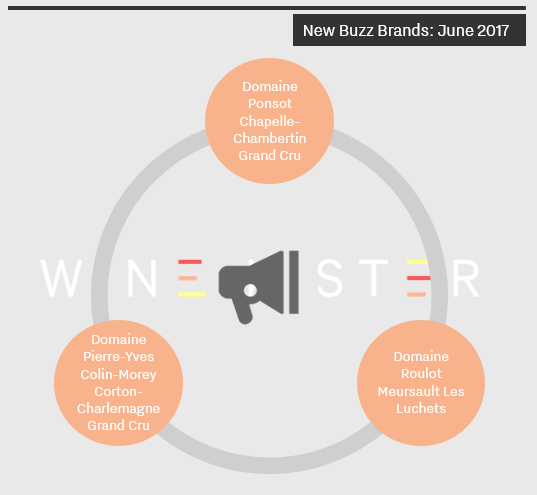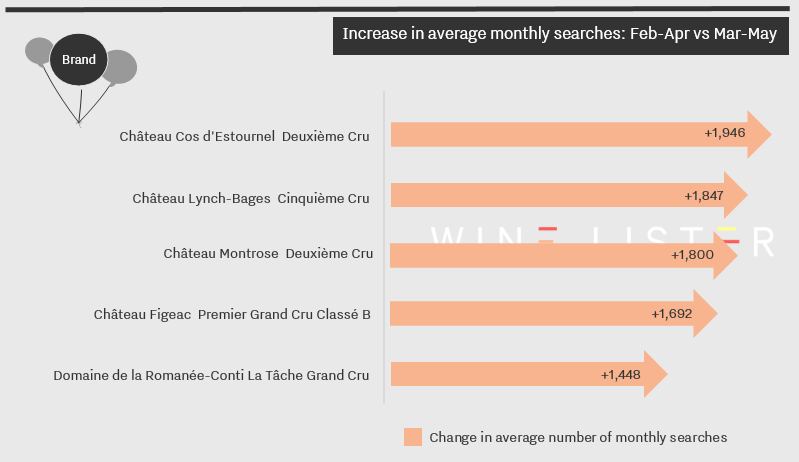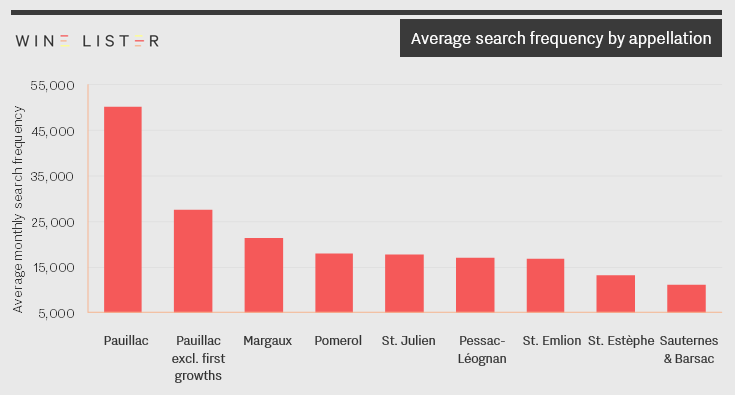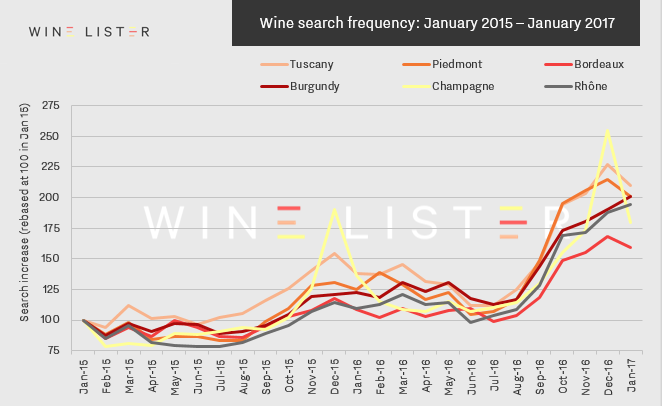Measuring the number of searches on the world’s most visited wine site, Wine-Searcher, provides a unique insight into a wine’s real consumer demand. With the latest online search data now in, we can determine whether there are any new “Buzz Brands”: one of the four Wine Lister Indicators, which were developed to isolate sub-sections of search criteria for our users. A Buzz Brand is a wine with strong distribution, showing high online search frequency or demonstrating a recent growth in popularity, and identified by the fine wine trade as trending or especially prestigious.
As shown in the chart below, three new wines achieved Buzz Brand status in June. To qualify, a wine must either be among the 20% most searched-for wines, or a wine whose search growth has significantly exceeded the rest of the group over the last six months. Domaine Pierre-Yves Colin-Morey Corton-Charlemagne Grand Cru saw an impressive 27% increase in average monthly searches over the last six months and also excels in terms of quality, with an average Quality score of 948.
The other two wines, Domaine Roulot Meursault Les Luchets and Domaine Ponsot Chapelle-Chambertin Grand Cru, saw their search frequency increase by 18% and 16% respectively over the latest six-month period. The latter has the highest overall Wine Lister score of the three, with 879/1000, and is the most expensive: £201 per bottle on average. Noticeably, all three wines are from Burgundy, a region whose online searches have been on the rise for some time.

With the latest online search frequency data in from Wine-Searcher we can now see which wines caught the public’s attention in May. Results demonstrate the effect of the 2016 en primeur campaign – now coming to a close – with Bordeaux brands taking four of the five top spots.
Cos d’Estournel saw online searches rise the most last month: the brand was one of the first out of the blocks with its 2016 release, which came in late April, maintaining the same price as its 2015. Exactly one month later, Lynch-Bages released its 2016 for €96 ex-négociant. Despite a 14% increase on 2015, the release went down well on the Place de Bordeaux, perhaps due to the wine achieving the highest Quality score of the century.

Montrose, which saw the third largest increase in searches in May, released its 2016 mid-month. With its Quality score up on 2009, 2010 and 2015, but, like neighbour Cos, releasing at the same price as 2015, Montrose 2016 looked like one of the vintage’s better buys. Figeac also saw searches soar in May but is something of an anomaly in this table – it only released its 2016 on Tuesday 13th June, too late to influence May’s search statistics. Nonetheless, the brand may well be garnering interest due to its exceptional Quality score, as rated by our three partner critics (Jancis Robinson in the UK, Bettane + Desseauve in France and Antonio Galloni in the US).
The final wine of the table, providing some respite from Bordeaux, is a heavyweight from Burgundy: DRC La Tâche. Two auctions in May – one from Sotheby’s and one from iDealwine – saw a number of bottles of La Tâche for sale, which may explain the boost in searches.
Earlier this month Wine Lister published its annual Bordeaux Market Study, and in recent weeks we’ve published a few nuggets from the 48-page long study on this blog (such as the top-scoring Bordeaux crus, and how to arrive at a 2016 release price). Today, we’re going to explore the popularity of Bordeaux’s individual appellations by looking at the online search frequency from our data partner Wine-Searcher for the six most popular wines of each.

Unsurprisingly, Pauillac – home to three of the five first growths – leads the way, with well over double the number of searches as nearest rival Margaux. If we exclude Châteaux Lafite, Mouton and Latour, the Pauillac average is just under 27,500 searches per month, still 29% ahead of Margaux.
Pomerol comes third, defying low production levels to achieve more average searches for its top wines than Saint-Julien. Pessac-Léognan benefits from the inclusion of Haut-Brion to help it edge ahead of Saint-Emilion, in spite of the latter’s four premiers grands crus classés A, while Saint-Estèphe and Sauternes & Barsac bring up the rear.
This is just a taster of the 2017 Bordeaux Market Study. You can download the full 48-page report from the Wine Lister Analysis page (subscribers only).
Measuring the number of searches on the world’s most visited wine site, Wine-Searcher, provides a unique insight into an individual wine’s overall popularity. Following on from last week’s blog on wine searches we have aggregated two years’ worth of this data at region level, to put popularity in perspective and map fine wine market trends over time.

Above, we have taken the 50 most searched-for wines from the leading fine wine regions in France and Italy and tracked their changes in search frequency over two years. Despite natural peaks and troughs – including large spikes for Champagne during the festive season – the last six months show an acceleration in searches for wines of every region.
Several wine regions have seen searches more than double in the last two years, with Tuscany, Piedmont and Burgundy as the stand-out performers. Meanwhile, Bordeaux – the most searched-for region in real terms – has struggled to engage new audiences at the same rate as its counterparts. For more on Tuscany’s rising global clout, see our in-depth regional study, available to subscribers on the Analysis page.
To view the popularity of individual wines, simply search for your wine of choice on Wine Lister and explore the Brand score sub-criteria.



